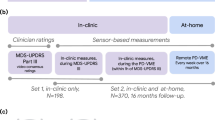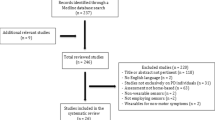Abstract
We aimed to assess the intrasubject reproducibility of a technology-based levodopa (LD) therapeutic monitoring protocol administered in supervised versus unsupervised conditions in patients with Parkinson’s disease (PD). The study design was pilot, intrasubject, single center, open and prospective. Twenty patients were recruited. Patients performed a standardized monitoring protocol instrumented by an ad hoc embedded platform after their usual first morning LD dose in two different randomized ambulatory sessions: one under a physician’s supervision, the other self-administered. The protocol is made up of serial motor and non-motor tests, including alternate finger tapping, Timed Up and Go test, and measurement of blood pressure. Primary motor outcomes included comparisons of intrasubject LD subacute motor response patterns over the 3-h test in the two experimental conditions. Secondary outcomes were the number of intrasession serial test repetitions due to technical or handling errors and patients’ satisfaction with the unsupervised LD monitoring protocol. Intrasubject LD motor response patterns were concordant between the two study sessions in all patients but one. Platform handling problems averaged 4% of total planned serial tests for both sessions. Ninety-five percent of patients were satisfied with the self-administered LD monitoring protocol. To our knowledge, this study is the first to explore the potential of unsupervised technology-based objective motor and non-motor tasks to monitor subacute LD dosing effects in PD patients. The results are promising for future telemedicine applications.

Similar content being viewed by others
References
Espay AJ, Bonato P, Nahab FB, Maetzler W, Dean JM, Klucken J et al (2016) Movement disorders society task force on technology technology in Parkinson’s disease: challenges and opportunities. Mov Disord 31:1272–1282
Maetzler W, Klucken J, Horne M (2016) A clinical view on the development of technology-based tools in managing Parkinson’s disease. Mov Disord 31:1263–1271
Dorsey ER, Vlaanderen FP, Engelen LJ, Kieburtz K, Zhu W, Biglan KM, Faber MJ, Bloem BR (2016) Moving Parkinson care to the home. Mov Disord 31:1258–1262
Homann CN, Suppan K, Wenzel K, Giovannoni G, Ivanic G, Horner S, Ott E, Hartung HP (2000) The bradykinesia akinesia incoordination test (BRAIN TEST), an objective and user-friendly means to evaluate patients with parkinsonism. Mov Disord 15:641–647
Pal PK, Lee CS, Samii A, Schulzer M, Stoessl AJ, Mak EK, Wudel J, Dobko T, Tsui JK (2001) Alternating two finger tapping with contralateral activation is an objective measure of clinical severity in Parkinson’s disease and correlates with PET. Parkinsonism Relat Disord 7:305–309
Taylor Tavares AL, Jefferis GS, Koop M, Hill BC, Hastie T, Heit G, Bronte-Stewart HM (2005) Quantitative measurements of alternate finger tapping in Parkinson’s disease correlate with UPDRS motor disability and reveal the improvement in fine motor control from medication and deep brain stimulation. Mov Disord 20:1286–1298
Podsiadlo D, Richardson S (1991) The timed “Up & Go”: a test of basic functional mobility for frail elderly persons. J Am Geriatr Soc 39:142–148
Contin M, Riva R, Martinelli P, Procaccianti G, Cortelli P, Avoni P, Baruzzi A (1990) Response to a standard oral levodopa test in parkinsonian patients with and without motor fluctuations. Clin Neuropharmacol 13:19–28
Contin M, Riva R, Martinelli P, Albani F, Avoni P, Baruzzi A (2001) Levodopa therapy monitoring in patients with Parkinson’s disease: a kinetic–dynamic approach. Ther Drug Monit 23:621–629
Calandra-Buonaura G, Doria A, Lopane G, Guaraldi P, Capellari S, Martinelli P, Cortelli P, Contin M (2016) Pharmacodynamics of a low subacute levodopa dose helps distinguish between multiple system atrophy with predominant Parkinsonism and Parkinson’s disease. J Neurol 263:250–256
Lang AE, Marras C (2014) Initiating dopaminergic treatment in Parkinson’s disease. Lancet 384:1164–1166
European innovation partnership on active and healthy ageing. Action group A1 (2013) A compilation of good practices. Prescription and adherence to medical plans. https://ec.europa.eu/research/innovation-union/pdf/active-healthy-ageing/gp_a1.pdf. Accessed 29 Nov 2017
Lopane G, Mellone S, Chiari L, Cortelli P, Calandra-Buonaura G, Contin M (2015) Dyskinesia detection and monitoring by a single sensor in patients with Parkinson’s Disease. Mov Disord 30:1267–1271
Gelb DJ, Oliver E, Gilman S (1999) Diagnostic criteria for Parkinson’s disease. Arch Neurol 56:33–39
Movement Disorder Society Task Force on Rating Scales for Parkinson’s Disease (2003) The Unified Parkinson’s Disease Rating Scale (UPDRS): status and recommendations. Mov Disord 18:738–750
Folstein MF, Folstein SE, McHugh PR (1975) Mini-mental state. A practical method for grading the cognitive state of patients for the clinician. J Psychiatry Res 12:189–198
Taylor JP, Rowan EN, Lett D, O’Brien JT, McKeith IG, Burn DJ (2008) Poor attentional function predicts cognitive decline in patients with non-demented Parkinson’s disease independent of motor phenotype. J Neurol Neurosurg Psychiatry 79:1318–1323
Irwin RP, Nutt JG, Woodward WR, Gancher ST (1992) Pharmacodynamics of the hypotensive effect of levodopa in parkinsonian patients. Clin Neuropharmacol 15:365–374
Hagell P, Widner H (1999) Clinical rating of dyskinesias in Parkinson’s disease: use and reliability of a new rating scale. Mov Disord 14:448–455
Tomlinson CL, Stowe R, Patel S, Rick C, Gray R, Clark CE (2010) Systematic review of levodopa dose equivalency reporting in Parkinson’s disease. Mov Disord 15:2649–2653
Stocchi F, Jenner P, Obeso JA (2010) When do levodopa motor fluctuations first appear in Parkinson’s disease? Eur Neurol 63:257–266
Shulman LM, Gruber-Baldini AL, Anderson KE, Fishman PS, Reich SG, Weiner WJ (2010) The clinically important difference on the Unified Parkinson’s disease Rating Scale. Arch Neurol 67:64–70
Arora S, Venkataraman V, Zhan A, Donohue S, Biglan KM, Dorsey ER, Little MA (2015) Detecting and monitoring the symptoms of Parkinson’s disease using smartphones: a pilot study. Parkinsonism Relat Disord 21:650–653
Mitsi G, Mendoza EU, Wissel BD, Barbopoulou E, Dwivedi AK, Tsoulos I, Stavrakoudis A, Espay AJ, Papapetropoulos S (2017) Biometric digital health technology for measuring motor function in Parkinson’s disease: results from a feasibility and patient satisfaction study. Front Neurol. https://doi.org/10.3389/fneur.2017.00273
Maetzler W, Rochester L (2015) Body-worn sensors—the brave new world of clinical measurement? Mov Disord 30:1203–1205
Toosizadeh N, Mohler J, Lei H, Parvaneh S, Sherman S, Najafi B (2015) Motor performance assessment in Parkinson’s disease: association between objective in-clinic, objective in-home, and subjective/semi-objective measures. PLoS One. https://doi.org/10.1371/journal.pone.0124763
Artusi CA, Mishra M, Latimer P, Vizcarra JA, Lopiano L, Maetzler W, Merola A, Espay AJ (2018) Integration of technology-based outcome measures in clinical trials of Parkinson and other neurodegenerative diseases. Parkinsonism Relat Disord 46(Suppl 1):S53–S56
Acknowledgements
Grant no. 451bis/2015 from “Fondazione del Monte di Bologna e Ravenna” is gratefully acknowledged. We thank the patients who participated in the study for their active cooperation. This study was presented at the 18th Annual Congress of the Italian Society of Clinical Movement Analysis (SIAMOC), Politecnico di Torino, Turin, Italy, 4th–7th October 2017. Anne Collins edited the English text.
Author information
Authors and Affiliations
Corresponding author
Ethics declarations
Conflicts of interest
G. Lopane and M. Corzani received a Grant from “Fondazione del Monte di Bologna e Ravenna” (Grant no. 451bis/2015). The other authors declare that they have no conflict of interest.
Ethical standards
The study was approved by the Ethics Committee of the Bologna-Imola Local Health Trust (Protocol number 15111) and was performed in accordance with the ethical standards of the Declaration of Helsinki and its later amendments. Patients gave their written informed consent to study participation.
Electronic supplementary material
Below is the link to the electronic supplementary material.
Rights and permissions
About this article
Cite this article
Lopane, G., Mellone, S., Corzani, M. et al. Supervised versus unsupervised technology-based levodopa monitoring in Parkinson’s disease: an intrasubject comparison. J Neurol 265, 1343–1352 (2018). https://doi.org/10.1007/s00415-018-8848-1
Received:
Revised:
Accepted:
Published:
Issue Date:
DOI: https://doi.org/10.1007/s00415-018-8848-1




